On September 11, 2024, the 25th China International Optoelectronic Exposition (CIOE 2024) opened at the Shenzhen International Convention and Exhibition Center. All the 12 exhibition halls of the center were rented, covering a display area of over 240,000 square meters. The exhibition attracted more than 3,700 optoelectronic companies worldwide, spanning multiple fields such as information and communication, precision optics, camera technology and applications, laser and smart manufacturing, infrared (IR) and ultraviolet (UV) radiation, smart sensing, and innovative display technologies.

In the exhibition zone for innovative display technologies, several companies showcased the latest Micro LED and Micro OLED displays as well as related optical components for microdisplay applications. Driven by the popularity of AR/VR glasses, microdisplay technology has drawn greater attention. However, microdisplays can actually be applied to a wider range of areas, including helmet display systems, night vision devices, FPV (first-person view) systems, electronic viewfinders, consumer electronics, healthcare, and aerospace.
At this year’s expo, in addition to applications in AR/VR glasses, microdisplay technology was also featured in innovative products like micro-projectors and micro-projection lamps, broadening the scope of its applications even further.
Furthermore, the latest applications of OLED and Mini LED in TVs, automotive displays, and wearable devices also became focal points in the innovative display technology zone.
Micro LED, Micro OLED Microdisplays and Optical Display Solutions
JBD

JBD unveiled its new high-brightness, high-resolution Hummingbird I polychrome optical module, along with the Hummingbird Mini II monochrome optical engine and other microdisplays powered by Micro LEDs. JBD also presented a series of AR smart glasses at the event.
Specifically, the new Hummingbird I, combined with an optical waveguide, achieves an in-eye brightness of over 6000 nits—significantly surpassing the previous range of 1000-2000 nits and overcoming limitations posed by ambient light. By integrating the industry’s first waveguide-based image quality correction solution, the ARTCs, the module offers dual quality correction of the optical engine and the optical waveguide, greatly improving brightness uniformity and significantly reducing color distortion and graininess. Additionally, the new module significantly reduces the rainbow effect, resulting in higher image purity. The Hummingbird I outputs a luminous flux of up to 6 lumens, with typical power consumption maintained at 150mW.

JBD’s Hummingbird I polychrome optical module
The new Hummingbird Mini II monochrome optical engine measures just 0.15 cubic centimeters and weighs only 0.3 grams, outputting a luminous flux of 8 lumens. Paired with an optical waveguide, it can achieve in-eye brightness exceeding 8000 nits. The company exhibited the engine for the first time at the SID 2024 exhibition and began mass producing and shipping it in 2Q24. New products based on this engine are expected to be released as early as September this year.

Hummingbird MiniII monochrome optical engine
Reportedly, there are currently 26 AR glasses models on the market adopting JBD’s solutions, with cumulative shipments of hundreds of thousands of units. Over 30 AR glasses models incorporating JBD’s technology are currently under development, most of which aim to integrate AI. Leveraging the production capacity of its Hefei factory, JBD will be able to ship microdisplays for millions of glasses models, aiming to scale to tens of millions in the next 3 to 5 years.
Saphlux

Saphlux showcased its T2-0.39-inch full-color AR microdisplay featuring 1641 PPI and a resolution of 512×384. Compared to the previous generation, the color gamut has been enhanced by 70%, and brightness has increased by 40%, reaching a peak brightness of 250,000 nits. The T1-0.12-inch AR monochrome green microdisplay boasts a resolution of 640×480 and a peak brightness of 3,000,000 nits.

T2-0.39-inch AR full-color microdisplay from Saphlux

T1-0.12-inch RGB monochrome green microdisplay
Saphlux’ current products include mLED chips for commercial large screens and automotive displays, as well as AR/VR microdisplays. It has overcome technical bottlenecks in full-color display and red light performance.
Saphlux’ self-developed monochrome Micro LED displays, the T1-0.12-inch red/green/blue series, have officially entered mass production. Samples of the T3-0.26-inch full-color model have been produced and, compared to the said T2-0.39-inch edition, achieves groundbreaking improvements in brightness and green color point/purity. Saphlux aims to make the next full-color model even smaller, aligning with the development trend of lightweight, efficient, and low-cost AR+AI products. Samples of this product are expected to be released by the end of 2024.
Sitan Technology

Sitan Technology’s Micro LED microdisplay modules employ monolithic integration technology, featuring improved product yield. They can provide R/G/B monochrome modules as well as full-color microdisplay modules based on quantum dot color conversion. The pixel size can be as small as 2μm, and the NTSC color space coverage can reach up to 120%. The company has so far filed over 800 intellectual property applications and more than 500 patent applications. Its mass production line was officially put into use this June, with an annual production capacity of over 6 million display modules.
At the event, Sitan also showcased several products, including 0.2- and 0.45-inch polychrome AR/XR display modules, 0.2- and 0.45-inch monochrome green Micro LED display modules, TFT-driven Micro LED display modules, 0.2-inch Micro LED white and green micro-projectors, and a white matrix car lamp.

Sitan’s 0.2- and 0.45-inch monochrome green and full-color display modules

TFT-driven Micro LED display module

Micro LED green micro-projectors (0.2 inches) and the white matrix car lamp
Raysolve

During the event, Raysolve unveiled a new microdisplay product line––the mass-production-level PowerMatch 1 full-color Micro LED displays. The 0.13-inch displays features a full-color resolution of 320×240 (Micro LED resolution of 640×480). Leveraging advancements in GaN and quantum dot materials and manufacturing processes, along with upgrades to the CMOS driver architecture, the PowerMatch 1 achieves a significant brightness increase while maintaining low power consumption. Its full-color peak brightness can now reach 250,000 nits, with wide color gamut covering 108.5% of the DCI-P3 standard and high color purity.

Micro LED microdisplay series from Raysolve
Lakeside Co.

At CIOE 2024, Lakeside Co. launched a new Pancake optical solution. The solution is built around its 1.31-inch 2.6K ultra-high resolution silicon-based Micro OLED microdisplay and is also compatible with a 1-inch Micro OLED microdisplay. This design achieves a field of view (FoV) of over 120° on a 1.31-inch microdisplay, and an overlap FoV of over 105° for both eyes using the 1-inch microdisplay. Achieving such a wide FoV on a small screen enables the use of smaller displays for AR devices, thereby reducing the overall size and weight of headsets while also significantly lowering their costs.

New Pancake optical solution from Lakeside
Lakeside also showcased Micro OLED microdisplays in sizes 0.26, 0.39, 0.49, 0.61, 0.99, and 1.31 inches. These displays feature full-color, black-and-white, and monochrome green display effects, with resolutions up to 2560×2560 pixels, maximum brightness of 10,000 nits, and frame rates up to 120Hz. The products also offer adjustable contrast and brightness modes, support low power modes, and feature dynamic Gamma correction. They can be used in IR night vision, camera electronic viewfinders (EVFs), AR/VR glasses, wearables, and more.

Micro OLED displays in sizes 0.26, 0.39, 0.49, 0.61, 0.99, and 1.31 inches
METAWAYS

METAWAYS showcased a 12-inch self-developed driver IC and full-color Micro OLED displays measuring 0.39, 0.6, 0.7, and 1.33 inches in size. The resolutions range from 1024(x3)x768 to 3840(x3)x2160, with maximum brightness reaching 3000 nits, contrast ratio over 100,000:1, and a maximum refresh rate of 120Hz.

Reportedly, METAWAYS’ microdisplay drivers are entirely self-designed, featuring high-performance and highly reliable electrodes. The components come with various packaging forms such as PCB and FPC and offer multiple interface options including RGB, LVDS, and MIPI.
Last month, according to news from the Chuzhou government, METAWAYS signed a contract for its 12-inch silicon-based Micro OLED microdisplay module project in Chuzhou, with an initial investment of 2 billion yuan. Once the first-phase project is completed, it will be able to produce 72,000 12-inch wafers annually, resulting in an annual output of 3 billion yuan.
Rayvision Technology

Rayvision Technology showcased a range of 0.39- to 1.3-inch full-color Micro OLED microdisplays. These displays boast resolutions up to 3552x3840, a maximum contrast ratio of 100,000:1, and peak brightness of 20,000 nits. The company’s near-eye displays can be applied to industrial design, aerospace, IR night vision, consumer electronics, FPV/EVFs and many other gadgets. Rayvision has product design and research centers located in North America, Shanghai, and Shenzhen. The first phase of its production line is situated in Qinzhou, Guangxi.
SIDTEK

SIDTEK showcased its Micro OLED microdisplays, available in sizes of 0.23, 0.49, and 0.68 inches. The products offer a maximum PPI of 4000 and refresh rates up to 120Hz. Notably, in June of this year, SIDTEK constructed a 12-inch Micro OLED panel production line in Wuhu, Anhui, and launched production. The total investment for this project is 6 billion yuan. The first-phase project will have a capacity of 6000 wafers per month (based on the Tandem OLED structure). The products from this production line are mainly targeted at ultra-high resolution display applications such as VR, AR, MR, EVF, and FPV systems.

SIDTEK’s 0.2-inch display

SIDTEK’s 0.6-inch display
SeeYA Technology

SeeYA Technology showcased its Micro OLED microdisplays ranging from 0.32 to 1.3 inches. The newly presented 0.6-inch screen is made using the 80-nanometer backplane process, with full-color brightness reaching up to 6000 nits and a wide color gamut of 100% DCI-P3 coverage. The product can dynamically adjust its refresh rate from 30Hz to 120Hz depending on different usage. It also comprises an ultra-low power MIPI interface combined with current drive technology, significantly enhancing product lifespan.

SeeYA’s OLEDoS microdisplays in sizes from 0.32 to 1.3 inches
Additionally, the company exhibited various optical modules, including a prismatic binocular hybrid waveguide as well as 1.03-inch Pancake lens, 0.72-inch lens group, and 0.6-inch BB binocular optical module.
Lumicore

At CIOE 2024, Lumicore showcased its latest silicon-based OLED microdisplays and digital driving technology, drawing significant attention from visitors. Particularly noteworthy was the 1.32-inch silicon-based OLED model SRS5025. This product boasts a display resolution of 2560x2560 and an impressive refresh rate of 3600Hz. Combined with advanced digital driving technology, it effectively eliminates motion blur and incorporates eye-friendly green display features. Additionally, this microdisplay supports HDR, significantly enhancing contrast and color gamut and thereby delivering an unprecedented visual experience for near-eye display systems.

Lumicore’s 1.32-inch Micro OLED display
Lumicore also presented an integrated AR display optical solution centered on a 0.71-inch silicon-based microdisplay, for which the manufacturer has launched mass production and can offer customized optical solutions such as Birdbath and freeform surfaces to meet various needs.

Lumicore’s 0.71-inch microdisplay
Guozhao Optoelectronics
Guozhao Optoelectronics unveiled several Micro OLED microdisplays as well as array optical waveguide modules. Specifically, the 0.2-inch product is the smallest silicon-based OLED in the industry, supporting monochrome green and polychrome high-brightness configurations. The presented products are energy-efficient and offer high brightness, small size, and a variety of interface options, which can be paired with optical systems with freeform surfaces and projection modules.

Micro OLED microdisplays from Guozhao

Micro-monitor powered by Micro OLEDs
SMARTVISION

SMARTVISION exhibited various products including silicon-based LCoS chips for microdisplays, silicon-based driving backplanes for Micro LED and Micro LED displays, and spatial light modulators. These devices boast significant advantages such as high resolution, high contrast, and low power consumption. They are widely applicable in emerging fields such as projection, optical communication, AR/VR/MR glasses, automotive HUDs, head-mounted displays, optical computing, 3D printing/3D scanning, and laser cutting.

LCoS microdisplay chips from SMARTVISION

Micro-projector

Micro OLED microdisplay

Micro LED microdisplay
Goeroptics

Goeroptics presented a variety of next-gen products and comprehensive optical solutions, including those involving XR, automotive vision, and micro-nano optics.
For the AR market, the exhibiter showcased the industry’s smallest and lightest full-color LCoS display AR optical engine and a Micro LED monochrome green AR display module featuring resin diffraction waveguides. Regarding VR displays, Goeroptics brought the high-performance Pancake module released in July, the C41, which enhances the immersive experience in virtual environments.

Goeroptics’ Micro LED microdisplay modules
In the automotive sector, Goeroptics introduced a coaxial dual-focal plane AR-HUD module powered by a single DLP4620 optical engine. Through light-combining design, this module achieves spatial overlap of distant and near virtual images, aligning them vertically when displayed, thereby improving driver focus and safety.
The company also showcased micro-nano optical components and 3D vision products at the event, including a 3D structured light intelligent access control system already in use and the industry’s first integrated facial recognition and QR code scanning door lock module.
Yancheng Hongshi Technology

Hongshi Technology set up three experience zones at the event, focusing on AR glasses, digital car lights, and micro-projection lamps powered by Micro LED microdisplay chips.
At the event, the manufacturer unveiled its A6 Micro LED microdisplay chip, offering a brightness of up to 8 million nits and a resolution of 6800 PPI. This chip features monochrome green display, measures only 0.12 inches, and is produced using 8-inch wafer-level silicon-based GaN chips. It also incorporates proprietary technologies such as quantum dot conversion and pixel isolation anti-crosstalk micro-lenses.

Hongshi A6 Micro LED
Moreover, the company showcased its intelligent digital automotive lighting solution, which incorporates the embedded Aurora A7 Micro LED optical engine. On the wall display, visitors could see road guidance information projected by the 1-million-nit optical engine. This solution is available in both monochrome green and polychrome display options.

Intelligent digital automotive lighting solution
Additionally, Hongshi exhibited an AR waveguide display module developed in collaboration with partners and micro-projection lamps featuring the embedded Aurora A6 Micro LED optical engine. Reportedly, the company has made breakthroughs in 8-inch silicon-based wafer substrate processing. With the construction of its new factory in Moganshan, Huzhou, Hongshi Technology is set to achieve an annual production capacity of 1,000,000 units.

Micro LED micro-projection lamps
ELEPN

ELEPN, in collaboration with ams OSRAM, jointly rolled out the μLED smart projection lamp MLP3000. Powered by 25,600 EVIYOS Shape Micro LED chips, the product offers a resolution of 320x80 and brightness of 3000 lm, with a wide projection range spanning from 1.5m to 50m. The projector features a compact size and wide field of view, making it suitable for applications such as digital signage, smart lighting, prompt messaging, instruction display, ambient lighting, and interactive gaming.

Text projected using MLP3000
ELEPN also showcased various products including a Micro LED monochrome green projection lamp, a μLED micro optical engine, DLP tri-color lasers, and full-color ultra-short throw tri-color laser optical engines. ELEPN focuses on the research, development, manufacturing, and marketing of ultra-thin micro projection optical engines, with products spanning fields like AR glasses, portable projectors, advertising displays, and automotive projectors. ELEPN holds over 100 patents related to ultra-short throw and laser display sectors, with nearly 20 of them being invention patents.
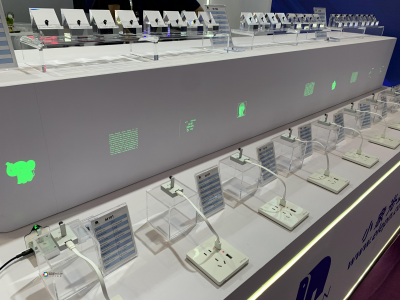
Micro LED monochrome green projection lamp from ELEPN

μLED micro-projector
NED+AR Display Technology
NED+AR showcased a variety of innovative optical solutions, including waveguide displays, freeform surface optical displays, and AI display terminals.
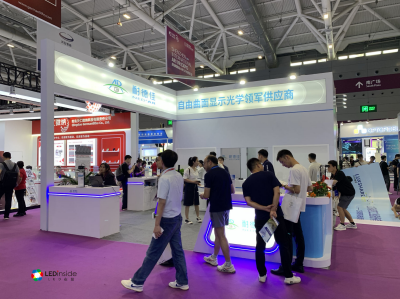
Among the highlights was NED+AR’s self-developed binocular geometric waveguide combined with a projection optical engine, making its debut. The waveguide display is ultra-thin and lightweight, featuring high transmittance, excellent color reproduction, clear display images, and uniform brightness.
The NED+AR freeform surface waveguide optical engine is engineered with lighting and imaging optical path reuse, which effectively reduces the size and weight of the optical waveguide projection system to about 1 cubic centimeter. Except for enhanced luminous efficiency, the product’s appearance is no different from regular glasses. Additionally, the company presented other optical solutions such as the freeform surface Diamond Pro and the innovative Mini-Pancake optical solution.
North Ocean Photonics

North Ocean Photonics is a high-tech enterprise specializing in wafer-level optics and photonic integration. Concerning optical applications, the manufacturer currently have three comprehensive product lines for micro-nano optics and machine vision, new augmented reality (AR) displays, and automotive and LiDAR systems. During the event, North Ocean Photonics showcased its technologies in micro-nano optics and machine vision, AR display diffraction waveguide solutions, optical engine communication, and automotive LiDAR solutions.

Micro-nano optics and machine vision and innovative AR displays from NOP
In the micro-nano optics and machine vision field, since 2019, the company has reportedly been mass producing 3D imaging wafer-level components for leading smartphone brands worldwide in consecutive years, with shipments exceeding tens of millions of units. Additionally, its AR display diffraction waveguides has been installed in the devices of several top-tier Chinese end-user companies, leading international and Chinese internet companies, and renowned unicorn companies in the AR industry. In the automotive and LiDAR sector, its products were verified by car manufacturers in 2021 and began applying them to the new energy vehicles of leading carmakers in China in 2022.

Automotive and LiDAR systems
Notably, during the exhibition, AR glasses manufacturer tooz showcased several models that come with North Ocean Photonics’ waveguide solutions.

tooz AR glasses driven by NOP’s waveguide solutions
TOPLITE
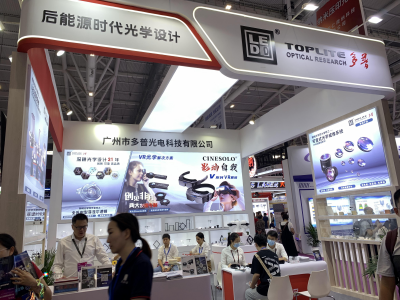
TOPLITE presented its new VR optical solutions (including lenses and engineering development modules) and a group of optical components at the exhibition. The solution provider also collaborated with CINESOLO to offer a pair of VR glasses offering new experiences for industry customers.
Specifically, the VR optical solution features a single-piece Pancake imaging system with a visual tilt compensation and adjustment structure.

Additionally, TOPLITE exhibited a variable optical imaging system, a multi-color LED mixing system, a high-power optical lens matrix module, and a total internal reflection (TIR) Fresnel lens. These components can be applied to devices such as LED pattern projection lamps, cut-off lights, and flashlights.
Goolton

Goolton showcased its comprehensive AR glasses solutions covering the entire industry chain, including display photoresist materials, volumetric holographic waveguide modules, AR glasses, and AR and AI algorithms.
In regard to waveguide AR glasses, Goolton presented the binocular high-brightness AR device H4000, the split AR+AI glasses G510, and the mixed reality system C5000 designed for diverse scenarios.

The H4000, released earlier this year, has undergone comprehensive upgrades in key factors such as display effects, image quality, noise reduction technology, network connectivity, wearing experience, and safety protection. Its optical display system can project a 160-inch screen from a distance of 6 meters, achieving a high 60% transmittance rate, a contrast ratio of 100,000:1, and 100% sRGB color coverage.
The C5000 device features a 200-inch high-resolution screen combined with centimeter-level spatial SLAM positioning technology, establishing a complete interaction system incorporating voice, head movement, gesture recognition, and physical buttons. The G510 glasses boast a lightweight design, ergonomic optimization, and adaptability to extreme environments.
To accelerate the integration of AR glasses with AI, Goolton also showcased the self-developed large model platform “Ravine”, which integrates the entire chain from network connection, data, and algorithms to service, application, and terminals. The company presented a full-stack solution combining AR and AI with digital twin and demonstrated its use in various sectors including aviation, customs, electric power, water services, rail transportation, petrochemicals, and heavy industry.
For waveguide products, Goolton exhibited three volumetric holographic waveguide modules including the H2026G, H3030G, and H3030DG. The H3040-V-G and H3040-V-M modules boast a DFoV (diagonal field of view) of 40° and a transmittance rate exceeding 80%, achieving two-dimensional pupil expansion and light loss in the range of 2%-3%. Additionally, these products come with more compact optical engines and lower manufacturing costs. The waveguide modules are equipped with Micro OLED displays, with a resolution of up to 1952x1232 and a field of view exceeding 45°.
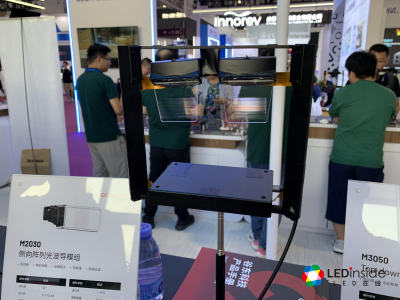
Waveguide modules from Goolton
In terms of materials, Goolton showcased the recently developed nano-imprint resin composite material featuring high refractive index (> 1.8), which enables AR glasses to achieve a larger field of view while maintaining high-resolution image quality.
GOOVIS

GOOVIS showcased various products including an UHD XR headset, optical engine modules for Micro OLED monocular/binocular near-eye displays, electronic viewfinders (EVF), and UHD near-eye display optical solutions at the event.

World’s first ultra-retina 4K UHD XR headset from GOOVIS
One of the major highlights was the world’s first-ever ultra-retina-level 4K ultra-high-definition XR headset. According to the parameters provided on-site, this headset comprises a 0.9-inch Micro OLED screen developed by BOE and ShiYan Tech, achieving a resolution of 3840x3840 with a PPI of 6020, making it the world’s silicon-based OLED screen with the highest PPI.
The headset is equipped with the company’s proprietary glass-plastic hybrid multiple aspheric (ASPH) lenses, achieving a display effect greater than 60 PPD with less than 1% optical distortion.
This is the world’s first ultra-retina-level single-eye 4K UHD VR headset, set to be widely used in viewing, gaming, medical surgery, and various high-end image visualization applications.
Additionally, GOOVIS presented the Art head-mounted 3D display, which features a Micro OLED binocular display with a 1920x1080 resolution. The device’s open-design headgear based on suspended mirror-free displays enables an exceptionally wide external real-world view.

GOOVIS Art
Moreover, GOOVIS exhibited several optical engine modules for Micro OLED monocular/binocular near-eye displays, characterized by a near-eye display system with a wide field of view, adjustable diopter, and high image quality across the entire field. These modules highlight features such as high image quality, high PPD, high luminous efficiency, ultra-low distortion, large-scale adjustable diopters, fine color grading, and wide color gamut. These products have been applied to simulation training, infrared thermal imaging, surgical robotics, drone FPV, autonomous vehicle remote control, ophthalmology and visual health, live streaming, viewing, and gaming.
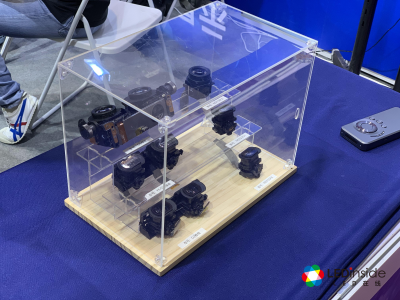
Optical engines for Micro LED monocular/binocular near-eye displays
Display Panels and Manufacturing Equipment
TCL
TCL showcased an LTPO COA VR fast LCD head-mounted display with 1700 PPI, featuring advanced LTPO backplane driving technology. This display offers high transmittance, low power consumption, and eco-friendly energy-saving characteristics. Additionally, it uses COA technology combined with Mini LED backlighting to provide refined display effects, effectively eliminating the screen-door effect.

TCL’s LTPO COA VR fast LCD head-mounted display with 1700 PPI
The company also presented a 21.6-inch OLED display for inkjet printing (IJP) with a 4K resolution, over 99% DCI-P3 wide color gamut coverage, and 10-bit high precision. Thanks to the Gen 5.5 IJP OLED mass production line and p-LTPS technology, and the adoption of a novel pixel arrangement, the display can effectively reduce blue light emission and alleviate visual fatigue for users.
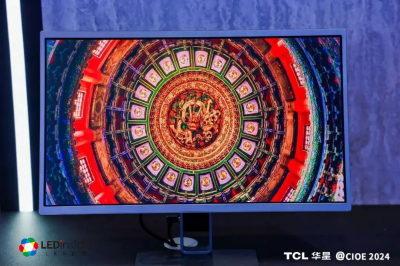
TCL’s 21.6-inch IJP OLED display
The manufacturer’s IJP OLED technology has gradually matured and will extend its application to more fields including medical, automotive, and IT displays (etc., tablets, notebooks). TCL plans to mass-produce and begin shipping IJP OLED products by the end of 2024.
Additionally, TCL showcased the world’s first 14-inch FHD Ln-Oxide display, the world’s first 85-inch 8K artistic glass display with a high refresh rate (manufactured using 4-mask technology), a 115-inch UD 4K TV display, a 2.8K eye-care educational tablet display, a 16-inch 120Hz TED integrated laptop display, a 6.9-inch ultra-flat UFG flexible and foldable OLED display, and a 29.8-inch automotive screen serving as the center console and co-driver display. These products cover applications for smartphones, monitors, TVs, and automotive displays.

TCL’s 85-inch 8K artistic glass display with a high refresh rate
Visionox

Visionox showcased various AMOLED products, including the world’s first AMOLED smart environment integration solution. This solution can be used for laptop displays and smart home decorations, featuring a transmittance rate of 50%, a brightness of 25 nits, and a contrast ratio of 60,000:1. The exhibitor also presented an AMOLED transparent all-in-one solution with a transmittance rate of 60%.

The world’s first AMOLED smart environment integration solution from Visionox

AMOLED transparent all-in-one solution
Additional highlights included the automotive AMOLED center console sliding solution and the AMOLED Real In-cell TP, which integrates touchscreen and display driving functions using TDD IIC.

Automotive AMOLED center console sliding solution
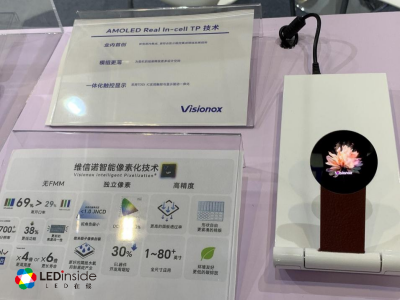
AMOLED Real In-cell TP technology
Super Power & Saultech
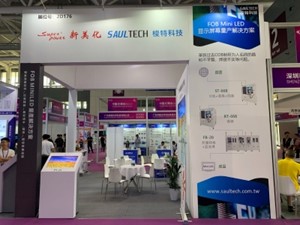
At the exhibition, Super Power, in collaboration with Saultech, showcased a comprehensive direct-view Mini LED display production solution called Film On Board (FOB). The suite comes with the three-in-one (sorting, mixing, and arrangement) machine (ST-668,) the RGB chip arrangement inspection and repair equipment (RT-668), and the mass transfer machine featuring automatic alignment and welding (FB-20).
The FOB solution allows for pre-arranging the pitch and precision of the chips during the mass transfer stage, followed by mass transfer and PCB board bonding. The entire PCB process can be completed in just 3-5 minutes and avoids the issue of solder paste drying out and causing inability to bond the dies, which can occur in conventional COB processes. This solution can save over 50% of the investment cost and ensures the yield and quality of mass-produced Mini LED displays.
At the event, the company exhibited a COB P0.9375 LED display, the GKXS, produced with FOB technology. This display features a 2K resolution and notably minimizes the halo effect that can appear when displaying black on Mini LED screens, thereby improving the contrast of the image.
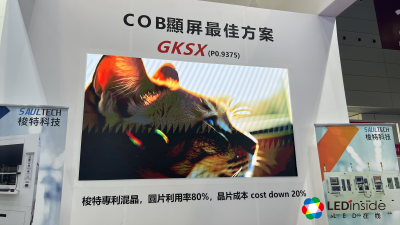
COB display from Super Power in collaboration with Saultech
Hymson

Hymson presented its latest achievements in the display field, including solutions for Micro LED laser mass transfer, Micro LED laser mass welding, and Micro LED laser mass repair. Additionally, it announced that the first Micro LED pilot line has recently managed to start shipping products, completing an in-house factory acceptance test.
Hymson also displayed its high-power mid-IR femtosecond laser system, femtosecond laser system, and battery micro-measurement instrument. Notably, the mid-IR femtosecond system is a newly launched product for this year, achieving a watt-level average power output (two watts) and freely tunable pulse wavelength output from 5 to 11 micrometers. This product has improved the conversion efficiency from near-IR to mid-IR femtosecond lasers by an order of magnitude (by Irving from LEDinside).
TrendForce 2024 Micro LED Market Trend and Technology Cost Analysis
Release: 31 May / 30 November 2024
Language: Traditional Chinese / English
Format: PDF
Page: 160-180
TrendForce 2024 Near-Eye Display Market Trend and Technology Analysis
Release Date:2024 / 07 / 31
Languages:Traditional Chinese / English
Format:PDF
Page:164
|
If you would like to know more details , please contact:
|
